Spring is just beginning to be sprung as I go back to my sit spot. The red maples are budding and the sky is dotted with the red clusters of growth and potential. The sugar maples and Norway maples are beginning to bud as well but not as aggressively or brightly as the acer rubrums. I have seen no amphibians near my spot. However, I did find a pair of coopers hawks that could be nesting directly behind my spot. This is the first and most exciting sign of wildlife and reproduction I have seen. There are no wildflowers in my spot but I can see fiddleheads all over the area, and I must resist picking them all and cooking them.
My sit spot is nested on the side of a hill where a northern hardwood forest mixed with pines meets a wetland. Where I am actually seated, on the trunk of a large downed white pine, is surrounded by hemlocks and maples. This spot would be classified as a northern hardwood community based on the tree species there, in the understory, and in the surrounding area. The area I look out over is a wetland. There should be cat-tails and other native wetland plants there, however phragmites have taken it over. Still, this community would be classified as a wetland.
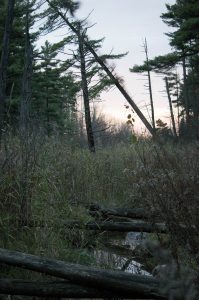
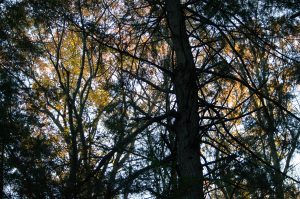
Posted in Uncategorized | Leave a Comment »
May has come and with it comes warmer weather, intense stress, and too many things to do. However, joy is found in May as many migratory bird species return and the trees begin to flower and leaf bringing color and song back to the woods. I frequently return to my phenology spot now. It is one of the only places to escape the monotony of the school week, relax, and feel a sense of peace. I return often to my spot for these reasons, but I also return to build relationships with some amazing creatures who often reside right next to me. I have seen the return of Barry the barred owl, and a pair of coopers hawks have picked a nest sight directly behind my spot.
I repeatedly go back to this nest sight to try and build a relationship with these birds. Although the relationship might not mean much to them it means excitement, discovery, and wonder for me that I am unable to find anywhere else. I have probably spent to many hours with these birds. I have had dinner with them and watched as they ate their poor unsuspecting songbird while I ate my granola bar. I got to watch some sort of mating ritual. I have even been able to witness them building their home. I feel as though they have let me into their lives as an observer. Ideally though, I would become their nanny and look after the eggs and chicks while they are off hunting, but I do not think we are that close yet.
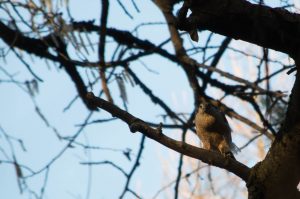

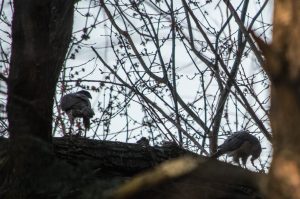
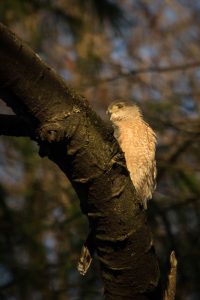

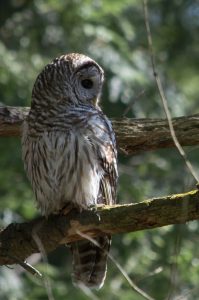
My biggest regret is that I will not be able to stay here longer and watch as fledglings develop and leave their nests. Oh how I wish I had a game camera to be able to capture the moments when they hatched and be able to observe the caring behavior of the adult coopers hawks. Alas, these experiences and revelations bus wait until I have more time here and more resources at my disposal.
Nature and culture intertwine at the edge of my spot. There are trails behind me and a baseball field over the ridge and these activities influence my spot in different ways. The field is fertilized and can have nutrient rich runoff into centennial brook that could mess up the makeup of the stream. The trail behind me mean that the spot is not truly wild, nor will it be very good interior undisturbed forest habitat. My spot still provides habitat for plenty of species and retains most of its ecosystem services all the same though. Behind my spot is where nature and culture intertwine. Centennial woods is where people go to connect with nature in the urban environment of Burlington.
I come to my spot to connect with nature as well. I do feel as though I have become a part of my spot or at least I hope I have. I hope the trees, flowers, birds, and land remembers me. I know the land will always remember me. There is an imprint in the dirt where I sit to birdwatch and watch the sun go down, there are paths I have trodden countless numbers of times to check on trees or track animals. The land will remember me. I hope that it will remember me well.

Posted in Uncategorized | 1 Comment »
Over this semester’s spring break I returned to my home in Arlington Virginia. My week was spent with friends, family, and in the woods. the first notable natural encounter from my break happened while driving through my suburban neighborhood. As I was cruising down the road a bird glided up right in front of my car and perched on a telephone wire thirty yards ahead of me. Since my eyes are attuned for movement in the sky and I’m always on the lookout for birds I immediately, and rather dangerously, pulled over to the side of the road and came to a screeching stop. I pulled out my trusty camera and bird book I carry with me everywhere I go and saw this beautiful guy.
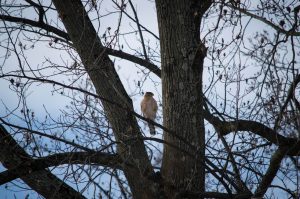
This is a coopers hawk. The same bird I was able to watch hunt and eat another bird. After that amazing experience I feel a connection to coopers hawks. So I leaned up against my car and simply observed. It is amazing that this creature I associate with the wild lives in and around my backyard in a largely metropolitan area.
The place I would call my sit spot over the break was in a wildlife refuge in Maryland called Patuxent Wildlife Research Center. I will be spending my summer there interning. The internship involves raising an endangered species of crane, the whooping crane, and releasing them into the wild. So, I decided to visit the refuge. The refuge is huge, along the Patuxent river, and near the Chesapeake bay. It is a relatively swampy area with lots of marshland and forest lining the river, much like my spot in centennial woods. However, the composition of flora and fauna was quite different. White pines were replaced with red pines, red oaks replaced with white oaks, and where maples dominate the Vermont forests beech dominate the Maryland ones. There were more birds there as well from ring necked ducks, to northern harriers. The migration reaches Maryland first.
It was a beautiful spring day in Virginia when I went out to the refuge. Virginia is two to three weeks ahead of Vermont for spring. The part of the refuge I visited had walking paths for visitors and was around a centralized visitor’s center. There are two large ponds and a river that the paths follow. I was lucky enough to see many ring necked ducks, some golden eyes, some mallards, a redwing blackbird, and a northern harrier!
I can’t wait for my place based knowledge about Patuxent to grow over the summer. And to develop new sit spots there.
Posted in Uncategorized | Leave a Comment »
After weeks of being away from the spot not much has changed. The hardwoods still have no leaves, the ground is still covered in snow, and the birds have not yet completely returned. Chickadees are still the majority of animals I see with gray squirrels coming in a close second. The biggest change is the scattering of branches and trees on the ground that had fallen after the ice storm. We lost many hemlock branches and a red maple tree.
The bud identification in my spot can be rather difficult. Most of the trees that have not been taken down by snow or ice are too tall to be able to see the buds. However, the yellow birch (betula aleghainiensis) buds are lower to the ground, and the long fuzzy cigar shapes stick out like hundreds of small bushy tails.
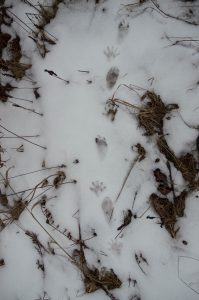
There are limited animal signs in my spot, a few squirrel and rabbit tracks here and there. However, on the way to the spot there are a plethora of tracks and signs. I found raccoon tracks running along the side of the retention pond, beaver tracks and feeding coming and going into the pond. Also deer I’ve seen deer tracks and and scar running from grove street all the way to my back entrance. Fox tracks criss cross all of centennial woods. However, all of the fox tracks I’ve followed end up in the cattail and phragmites marsh where centennial brook meets grove street. There I’ve seen fox tracks hunting mice, and continuing along the woods into people back yards. The woods in the winter open up like a book.
Posted in Uncategorized | Leave a Comment »
This past week’s snowfall has added a new element to the experience in Centennial Woods, tracking. For the most part, larger animals stay hidden from human view during the day. However, when snow falls evidence of their movements and activities become visible. After the first snow fall I bundled up and ran out to the woods as soon as I could. Although I saw no-one stirring, besides a few hardy chickadees and the maples and pines in the wind, I could see the movement of people, dogs, and deer over the past few hours. I found what I determined to be fox tracks and followed them through the woods for hours trying to determine what they did while no one was looking. This experience of tracking an animal through the woods made me more aware and more thoughtful. I was trying to think like a fox. “Why would the tracks lead this way?” And, when I lost the tracks I had to think like a fox to find them again and continue on. This experience gave me a greater insight into the lives of beings I rarely get to see.
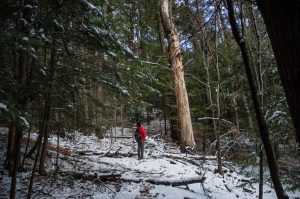
The snow also allowed me an insight into the world of Barry the Barred Owl (I do not know the gender of this owl but I am going to refer to him as he/him). I have three places in the woods where i think this owl is roosting/living. One of the signs that he is roosting in a place is owl pellets on the ground around him. Owl pellets are fur and bones that Barry could not digest that have been regurgitated. Normally it is quite hard to find owl pellets. However, one day I was inspecting the ground around the area I though he was roosting in and I saw him 15 feet up perched in a hemlock tree. I nearly screamed in excitement and fear. I was almost directly under him and his piercing black eyes were staring down at me. The scariest part is that he had been there the whole time and I had no idea. After taking a few pictures of him as proof and just sitting in awe of him he was bothered by some birds and flew up a hill and away into the trees. I completely forgot my interest in pellets and ran up the ridge after him. I spotted him three quarters up a tall pine quite far from me. He heard me, looked at me then jumped and flew off in silence.

After catching my breath and looking at the mediocre pictures I got of him I had an idea. What if he had regurgitated something while sitting in the hemlock? I knew the exact spot he had been sitting and if he had it confirms my suspicions about him roosting in this area. So, I made a big loop continuously scanning for him back to his hemlock. Underneath his perch I searched around the lightly snow-covered ground and struck gold. Well, I guess it was more of a black color but it might as well have been gold for me. Three owl pellets had been deposited directly under the hemlock! Elated, I began to call people who could possibly bring me a plastic bag to collect these treasures of information. The only person who responded to my call was Luke Huntington. He rushed down to the woods with a bag. While he brought the bag I began to dissect the pellets with two sticks. Peeling apart the black fur I came across tiny leg bones first, then lower jaws, then the skull of two mice/small rodents! These pellets are windows into he world of Barry. Not only do I know what he is eating, I know how much, when, and where he is most likely roosting!

The snow came with some great surprises.
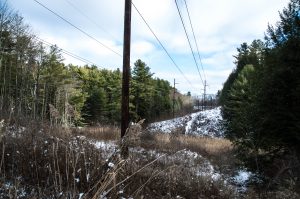
Posted in Uncategorized | 3 Comments »
Centennial woods has a interesting use history. Initially the land that is now designated as a natural area was farmland. Most everything was clearcut except for a few trees that one can see evidence of in the forest now. Then after the field was abandoned pines began to repopulate the area. The largest pines in the pine stands in centennial can be up to 150 years old!
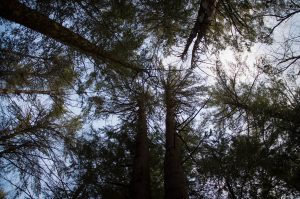
Centennial woods also has had development around all of its edges. Houses and communities have gone up around its entrances and a baseball field, soccer field, and electrical plant are all in the same area right next to my entrance and spot. These human developments all have dangerous consequences. Dangerous runoff from the developments can affect Centennial Brook and the woods. To mitigate these problems a series of three retention ponds have been created. These human developments actually seem to be benefiting the wildlife in the woods. The retention ponds are where I see the highest concentration of wildlife. Once there was a beaver, muskrat, and two mallards in the ponds with a woodpecker on a snag next to the pond and a hawk flying over it. The bird sightings were probably just coincidences but the muskrat, beaver and water fowl greatly benefit from these ponds.

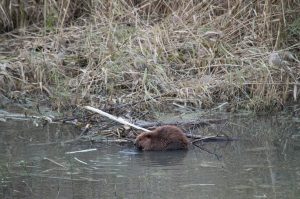
Other than these developments the woods are heavily foot trafficked with families, runners, dogs, classes, and other naturalists.
Posted in Uncategorized | 1 Comment »
Over the relaxing thanksgiving break I went back to my home in Arlington Virginia. For this blog post I chose the closest national park to my house, Great Falls National Park. This park straddles the potomac river and is characterized by the rushing river, great falls, and steep cliffs.
Virginia is a few weeks behind Vermont in fall. Many of the leaves were still clinging to the trees, and some of the birds that were migrating through Vermont a couple of weeks ago are making their way through Virginia. After close observation of my spot I realized how specific ecological knowledge is to the place. In my spot in Centennial Woods I can name almost every tree and birds I see. However, in Virginia I am way more hesitant and only a few of the trees are familiar to me. Instead of maples dominating the woods oaks populate most areas in the park and in the suburbs. White oaks outnumber red oaks and there are no sugar maples. Tulip trees are abundant all over the area, beeches take the places of maples, yellow bellied sapsuckers replace the harry woodpeckers, and ring necked ducks and cormorants do the diving with ought any loons. Along the edges of the rivers and tops of the cliffs red pines stand gnarled and flakey instead of the tall straight white pines of Vermont.
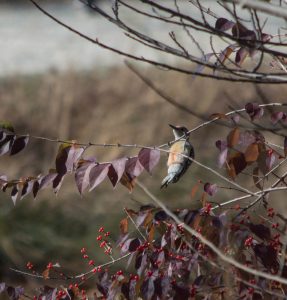
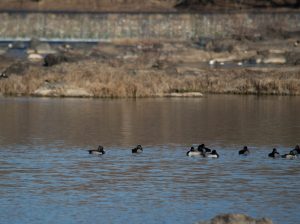
There are many similarities between the two spots as well. Red oaks and elms are prevalent in both areas. Cardinals, chickadees, robins, and mallards are abundant in both locations. Red tailed hawks soar over both Centennial Woods and Great Falls. The biggest similarity in both locations is the amazing amount of wildlife in some seemingly urban locations.

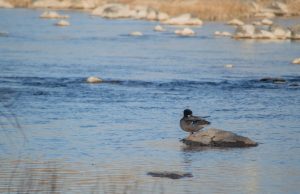
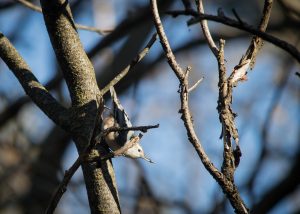
Posted in Uncategorized | Leave a Comment »
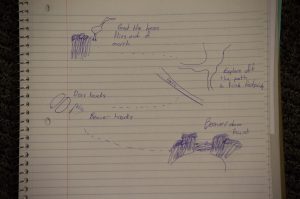
The newest addition to my sit spot is the close proximity to a beaver dam! Other than that most of the hardwood canopy has disappeared and all that is left is the towering white pines with there evergreen needles. Also the composition of birds I see when sitting in my spot has changed. There are a significantly less number of birds overall. There are no robins, very few sparrows, and now instead of seeing the pileated woodpeckers I just hear them cackling around the forest. The chickadees still densely populate the forest around me and the jays continue to point out danger to the entire forest with their unmistakable call.
Addicted
I am addicted
addicted to silence
to the peace and tranquility
the world without violence
I am addicted
addicted to life
how it grows and is carved
without use of a knife
I need it like a mother needs her child
I am addicted
Addicted to the wild
Posted in Uncategorized | 1 Comment »
This week was a week of discoveries. I discovered, first and foremost, a barred owl and most likely where it roosts. I have taken to calling him Barry. The location of his home has to be kept a secret so he is not disturbed. I feel bad exploring the area because every time I walk through it I know he is there, and even if I don’t see him I know he knows exactly where I am.
Actually finding him was quite an experience. I have seen him three separate times now and two days in a row. The first time I spotted him I was only able to observe him for ten minute before he left and I lost sight of him. The second time my friend and fellow NR1 student, Luke, saw him just as we were leaving the woods. He was asleep in the cold rain just over where we had walked. We proceeded to find a seat under a sugar maple in the pouring rain and watch him sleep for forty minutes before he woke up and began to prune himself, much like a cat. This little display yielded about three hundred pictures only a few of which were acceptable.
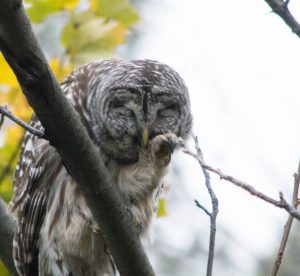
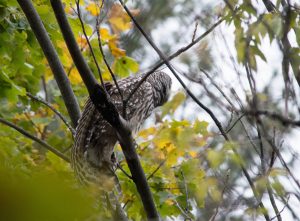
The next day we went back and found him in the same general area. We came in looking for him and had no luck, but as soon as we decided to give up hope and look for some pileated woodpeckers he swooped down right in front of both of us, leaving our mouths agape and our eyes in awe. He looked like a stealth bomber gliding and weaving among the trees effortlessly. He quickly disappeared into the dense brush and we lost sight of him. Minutes later we heard an eruption of bluejays, cardinals, and chickadees. Making our way to the spot of all the commotion we found him again being pestered by a jay. The birds’ alarm calls lead us right to him. He was much more active this time and we assumed he was hunting so we left him be for an hour or so. As we returned to where he was last seen we had little hope he would be there. However, Barry gave us one last show. In the almost pitch black he was silhouetted against the sky and just as we noticed him he dropped off his perch gave three silent flaps of his enormous wings and was gone into the night. There is nothing more mysterious, exciting, scary, and awe inspiring then seeing an active owl at dusk.
The second discovery was of a beaver living in centennial woods and his dam. The same day Luke and I spent some time with Barry we spotted a large furry creature in the retention pond on the edge of centennial woods. After some further research mostly involving asking Professor Poleman we realized it was a beaver.
Today I found more evidence of beavers living in centennial. Walking down the hill past the retention pond I am always looking around with my eyes peeled for birds or interesting creatures. Out of the corner of my eye I spot a great blue heron gracefully soar out of the marsh. I decided to try and find some evidence of this heron because I see it quite often but I am unable to get a decent picture of it. After fighting through a thicket of small black locust trees with massive thorns I make it to the small clearing in the marsh where centennial brook meanders and the banks are free from vegetation. I scan the banks looking for heron footprints in the mud, no luck. However I did find some initially unknown tracks along with some deer footprints.
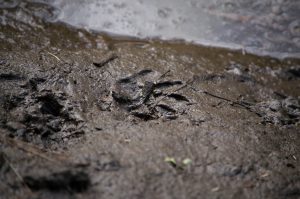
I decided to follow these footprints which was no easy task. Avoiding the brook, tracks, and vegetation lead to quite a few slips and some wet socks, but eventually I made it to the middle of the marsh. Looking up from the tracks the stream widened and there was a small pond in front of me. At the far end of the pond was what I assume to be a beaver dam! It turns out that this dam is less that one hundred yards away from my spot up the marsh. The heron was what lead me to the dam and now he and I are able to reap the benefits from it. The heron gets a pond for hunting and I get a place to watch for heron, beaver, and to learn more about how beavers affect the ecosystem of centennial woods/my spot!
The third discovery was less exciting but only slightly less important. I was able to see a hairy woodpecker and a downy woodpecker in close succession. So, now I know the difference. I was only able to get pictures of the downy woodpecker, but the hairy woodpecker is larger and has a longer beak.
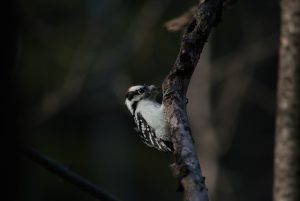
Posted in Uncategorized | 1 Comment »